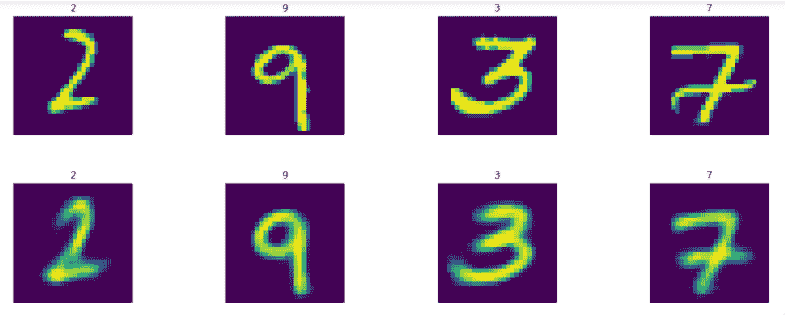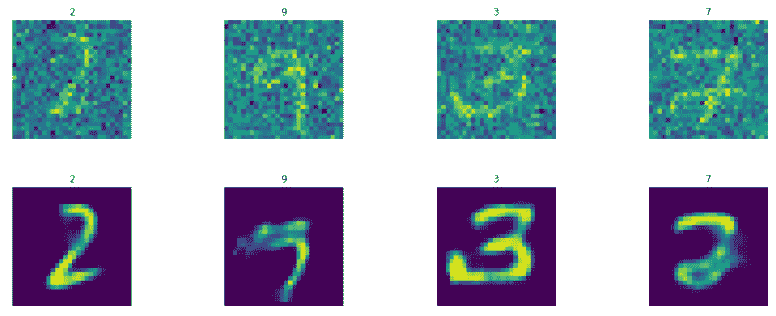# Keras 中的變分自編碼器
在 Keras 中,構建變分自編碼器更容易,并且代碼行更少。 Keras 變分自編碼器最好使用函數式風格構建。到目前為止,我們已經使用了在 Keras 中構建模型的順序樣式,現在在這個例子中,我們將看到在 Keras 中構建 VAE 模型的函數式風格。在 Keras 建立 VAE 的步驟如下:
1. 定義隱藏層和潛在變量層中的超參數和神經元數量:
```py
import keras
from keras.layers import Lambda, Dense, Input, Layer
from keras.models import Model
from keras import backend as K
learning_rate = 0.001
batch_size = 100
n_batches = int(mnist.train.num_examples/batch_size)
# number of pixels in the MNIST image as number of inputs
n_inputs = 784
n_outputs = n_inputs
# number of hidden layers
n_layers = 2
# neurons in each hidden layer
n_neurons = [512,256]
# the dimensions of latent variables
n_neurons_z = 128
```
1. 構建輸入層:
```py
x = Input(shape=(n_inputs,), name='input')
```
1. 構建編碼器層,以及潛在變量的均值和方差層:
```py
# build encoder
layer = x
for i in range(n_layers):
layer = Dense(units=n_neurons[i], activation='relu',name='enc_{0}'.format(i))(layer)
z_mean = Dense(units=n_neurons_z,name='z_mean')(layer)
z_log_var = Dense(units=n_neurons_z,name='z_log_v')(layer)
```
1. 創建噪聲和后驗分布:
```py
# noise distribution
epsilon = K.random_normal(shape=K.shape(z_log_var),
mean=0,stddev=1.0)
# posterior distribution
z = Lambda(lambda zargs: zargs[0] + K.exp(zargs[1] * 0.5) * epsilon,
name='z')([z_mean,z_log_var])
```
1. 添加解碼器層:
```py
# add generator / probablistic decoder network layers
layer = z
for i in range(n_layers-1,-1,-1):
layer = Dense(units=n_neurons[i], activation='relu',
name='dec_{0}'.format(i))(layer)
```
1. 定義最終輸出層:
```py
y_hat = Dense(units=n_outputs, activation='sigmoid',
name='output')(layer)
```
1. 最后,從輸入層和輸出層定義模型并顯示模型摘要:
```py
model = Model(x,y_hat)
model.summary()
```
我們看到以下摘要:
```py
_________________________________________________________________________
Layer (type) Output Shape Param # Connected to
=========================================================================
input (InputLayer) (None, 784) 0
_________________________________________________________________________
enc_0 (Dense) (None, 512) 401920 input[0][0]
_________________________________________________________________________
enc_1 (Dense) (None, 256) 131328 enc_0[0][0]
_________________________________________________________________________
z_mean (Dense) (None, 128) 32896 enc_1[0][0]
_________________________________________________________________________
z_log_v (Dense) (None, 128) 32896 enc_1[0][0]
_________________________________________________________________________
z (Lambda) (None, 128) 0 z_mean[0][0]
z_log_v[0][0]
_________________________________________________________________________
dec_1 (Dense) (None, 256) 33024 z[0][0]
_________________________________________________________________________
dec_0 (Dense) (None, 512) 131584 dec_1[0][0]
_________________________________________________________________________
output (Dense) (None, 784) 402192 dec_0[0][0]
=========================================================================
Total params: 1,165,840
Trainable params: 1,165,840
Non-trainable params: 0
_________________________________________________________________________
```
1. 定義一個計算重建和正則化損失之和的函數:
```py
def vae_loss(y, y_hat):
rec_loss = -K.sum(y * K.log(1e-10 + y_hat) + (1-y) *
K.log(1e-10 + 1 - y_hat), axis=-1)
reg_loss = -0.5 * K.sum(1 + z_log_var - K.square(z_mean) -
K.exp(z_log_var), axis=-1)
loss = K.mean(rec_loss+reg_loss)
return loss
```
1. 使用此損失函數來編譯模型:
```py
model.compile(loss=vae_loss,
optimizer=keras.optimizers.Adam(lr=learning_rate))
```
1. 讓我們訓練 50 個周期的模型并預測圖像,正如我們在前面的部分中所做的那樣:
```py
n_epochs=50
model.fit(x=X_train_noisy,y=X_train,batch_size=batch_size,
epochs=n_epochs,verbose=0)
Y_test_pred1 = model.predict(test_images)
Y_test_pred2 = model.predict(test_images_noisy)
```
讓我們顯示結果圖像:
```py
display_images(test_images.reshape(-1,pixel_size,pixel_size),test_labels)
display_images(Y_test_pred1.reshape(-1,pixel_size,pixel_size),test_labels)
```
我們得到如下結果:

```py
display_images(test_images_noisy.reshape(-1,pixel_size,pixel_size),
test_labels)
display_images(Y_test_pred2.reshape(-1,pixel_size,pixel_size),test_labels)
```
我們得到以下結果:

這很棒!!生成的圖像更清晰,更清晰。
- TensorFlow 101
- 什么是 TensorFlow?
- TensorFlow 核心
- 代碼預熱 - Hello TensorFlow
- 張量
- 常量
- 操作
- 占位符
- 從 Python 對象創建張量
- 變量
- 從庫函數生成的張量
- 使用相同的值填充張量元素
- 用序列填充張量元素
- 使用隨機分布填充張量元素
- 使用tf.get_variable()獲取變量
- 數據流圖或計算圖
- 執行順序和延遲加載
- 跨計算設備執行圖 - CPU 和 GPU
- 將圖節點放置在特定的計算設備上
- 簡單放置
- 動態展示位置
- 軟放置
- GPU 內存處理
- 多個圖
- TensorBoard
- TensorBoard 最小的例子
- TensorBoard 詳情
- 總結
- TensorFlow 的高級庫
- TF Estimator - 以前的 TF 學習
- TF Slim
- TFLearn
- 創建 TFLearn 層
- TFLearn 核心層
- TFLearn 卷積層
- TFLearn 循環層
- TFLearn 正則化層
- TFLearn 嵌入層
- TFLearn 合并層
- TFLearn 估計層
- 創建 TFLearn 模型
- TFLearn 模型的類型
- 訓練 TFLearn 模型
- 使用 TFLearn 模型
- PrettyTensor
- Sonnet
- 總結
- Keras 101
- 安裝 Keras
- Keras 中的神經網絡模型
- 在 Keras 建立模型的工作流程
- 創建 Keras 模型
- 用于創建 Keras 模型的順序 API
- 用于創建 Keras 模型的函數式 API
- Keras 層
- Keras 核心層
- Keras 卷積層
- Keras 池化層
- Keras 本地連接層
- Keras 循環層
- Keras 嵌入層
- Keras 合并層
- Keras 高級激活層
- Keras 正則化層
- Keras 噪音層
- 將層添加到 Keras 模型
- 用于將層添加到 Keras 模型的順序 API
- 用于向 Keras 模型添加層的函數式 API
- 編譯 Keras 模型
- 訓練 Keras 模型
- 使用 Keras 模型進行預測
- Keras 的附加模塊
- MNIST 數據集的 Keras 序列模型示例
- 總結
- 使用 TensorFlow 進行經典機器學習
- 簡單的線性回歸
- 數據準備
- 構建一個簡單的回歸模型
- 定義輸入,參數和其他變量
- 定義模型
- 定義損失函數
- 定義優化器函數
- 訓練模型
- 使用訓練的模型進行預測
- 多元回歸
- 正則化回歸
- 套索正則化
- 嶺正則化
- ElasticNet 正則化
- 使用邏輯回歸進行分類
- 二分類的邏輯回歸
- 多類分類的邏輯回歸
- 二分類
- 多類分類
- 總結
- 使用 TensorFlow 和 Keras 的神經網絡和 MLP
- 感知機
- 多層感知機
- 用于圖像分類的 MLP
- 用于 MNIST 分類的基于 TensorFlow 的 MLP
- 用于 MNIST 分類的基于 Keras 的 MLP
- 用于 MNIST 分類的基于 TFLearn 的 MLP
- 使用 TensorFlow,Keras 和 TFLearn 的 MLP 總結
- 用于時間序列回歸的 MLP
- 總結
- 使用 TensorFlow 和 Keras 的 RNN
- 簡單循環神經網絡
- RNN 變種
- LSTM 網絡
- GRU 網絡
- TensorFlow RNN
- TensorFlow RNN 單元類
- TensorFlow RNN 模型構建類
- TensorFlow RNN 單元包裝器類
- 適用于 RNN 的 Keras
- RNN 的應用領域
- 用于 MNIST 數據的 Keras 中的 RNN
- 總結
- 使用 TensorFlow 和 Keras 的時間序列數據的 RNN
- 航空公司乘客數據集
- 加載 airpass 數據集
- 可視化 airpass 數據集
- 使用 TensorFlow RNN 模型預處理數據集
- TensorFlow 中的簡單 RNN
- TensorFlow 中的 LSTM
- TensorFlow 中的 GRU
- 使用 Keras RNN 模型預處理數據集
- 使用 Keras 的簡單 RNN
- 使用 Keras 的 LSTM
- 使用 Keras 的 GRU
- 總結
- 使用 TensorFlow 和 Keras 的文本數據的 RNN
- 詞向量表示
- 為 word2vec 模型準備數據
- 加載和準備 PTB 數據集
- 加載和準備 text8 數據集
- 準備小驗證集
- 使用 TensorFlow 的 skip-gram 模型
- 使用 t-SNE 可視化單詞嵌入
- keras 的 skip-gram 模型
- 使用 TensorFlow 和 Keras 中的 RNN 模型生成文本
- TensorFlow 中的 LSTM 文本生成
- Keras 中的 LSTM 文本生成
- 總結
- 使用 TensorFlow 和 Keras 的 CNN
- 理解卷積
- 了解池化
- CNN 架構模式 - LeNet
- 用于 MNIST 數據的 LeNet
- 使用 TensorFlow 的用于 MNIST 的 LeNet CNN
- 使用 Keras 的用于 MNIST 的 LeNet CNN
- 用于 CIFAR10 數據的 LeNet
- 使用 TensorFlow 的用于 CIFAR10 的 ConvNets
- 使用 Keras 的用于 CIFAR10 的 ConvNets
- 總結
- 使用 TensorFlow 和 Keras 的自編碼器
- 自編碼器類型
- TensorFlow 中的棧式自編碼器
- Keras 中的棧式自編碼器
- TensorFlow 中的去噪自編碼器
- Keras 中的去噪自編碼器
- TensorFlow 中的變分自編碼器
- Keras 中的變分自編碼器
- 總結
- TF 服務:生產中的 TensorFlow 模型
- 在 TensorFlow 中保存和恢復模型
- 使用保護程序類保存和恢復所有圖變量
- 使用保護程序類保存和恢復所選變量
- 保存和恢復 Keras 模型
- TensorFlow 服務
- 安裝 TF 服務
- 保存 TF 服務的模型
- 提供 TF 服務模型
- 在 Docker 容器中提供 TF 服務
- 安裝 Docker
- 為 TF 服務構建 Docker 鏡像
- 在 Docker 容器中提供模型
- Kubernetes 中的 TensorFlow 服務
- 安裝 Kubernetes
- 將 Docker 鏡像上傳到 dockerhub
- 在 Kubernetes 部署
- 總結
- 遷移學習和預訓練模型
- ImageNet 數據集
- 再訓練或微調模型
- COCO 動物數據集和預處理圖像
- TensorFlow 中的 VGG16
- 使用 TensorFlow 中預訓練的 VGG16 進行圖像分類
- TensorFlow 中的圖像預處理,用于預訓練的 VGG16
- 使用 TensorFlow 中的再訓練的 VGG16 進行圖像分類
- Keras 的 VGG16
- 使用 Keras 中預訓練的 VGG16 進行圖像分類
- 使用 Keras 中再訓練的 VGG16 進行圖像分類
- TensorFlow 中的 Inception v3
- 使用 TensorFlow 中的 Inception v3 進行圖像分類
- 使用 TensorFlow 中的再訓練的 Inception v3 進行圖像分類
- 總結
- 深度強化學習
- OpenAI Gym 101
- 將簡單的策略應用于 cartpole 游戲
- 強化學習 101
- Q 函數(在模型不可用時學習優化)
- RL 算法的探索與開發
- V 函數(模型可用時學習優化)
- 強化學習技巧
- 強化學習的樸素神經網絡策略
- 實現 Q-Learning
- Q-Learning 的初始化和離散化
- 使用 Q-Table 進行 Q-Learning
- Q-Network 或深 Q 網絡(DQN)的 Q-Learning
- 總結
- 生成性對抗網絡
- 生成性對抗網絡 101
- 建立和訓練 GAN 的最佳實踐
- 使用 TensorFlow 的簡單的 GAN
- 使用 Keras 的簡單的 GAN
- 使用 TensorFlow 和 Keras 的深度卷積 GAN
- 總結
- 使用 TensorFlow 集群的分布式模型
- 分布式執行策略
- TensorFlow 集群
- 定義集群規范
- 創建服務器實例
- 定義服務器和設備之間的參數和操作
- 定義并訓練圖以進行異步更新
- 定義并訓練圖以進行同步更新
- 總結
- 移動和嵌入式平臺上的 TensorFlow 模型
- 移動平臺上的 TensorFlow
- Android 應用中的 TF Mobile
- Android 上的 TF Mobile 演示
- iOS 應用中的 TF Mobile
- iOS 上的 TF Mobile 演示
- TensorFlow Lite
- Android 上的 TF Lite 演示
- iOS 上的 TF Lite 演示
- 總結
- R 中的 TensorFlow 和 Keras
- 在 R 中安裝 TensorFlow 和 Keras 軟件包
- R 中的 TF 核心 API
- R 中的 TF 估計器 API
- R 中的 Keras API
- R 中的 TensorBoard
- R 中的 tfruns 包
- 總結
- 調試 TensorFlow 模型
- 使用tf.Session.run()獲取張量值
- 使用tf.Print()打印張量值
- 用tf.Assert()斷言條件
- 使用 TensorFlow 調試器(tfdbg)進行調試
- 總結
- 張量處理單元
